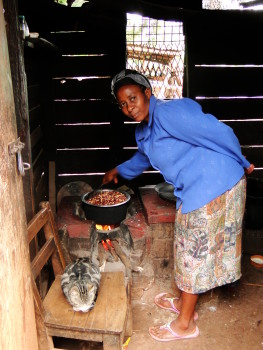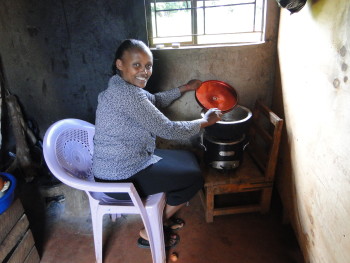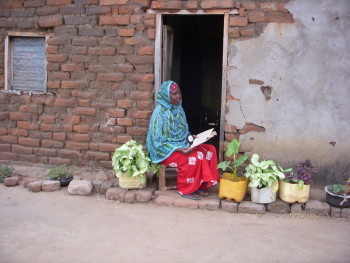Below is a reposted abstract from a study by Bensch, et al.: The intensive margin of technology adoption — Experimental evidence on improved cooking stoves in rural Senegal.
Today, almost 3 billion people in developing countries rely on biomass as primary cooking fuel, with profound negative implications for their well-being. Improved biomass cooking stoves are alleged to counteract these adverse effects. This paper evaluates take-up and impacts of low-cost improved stoves through a randomized controlled trial. The randomized stove is primarily designed to curb firewood consumption, but not smoke emissions. Nonetheless, we find considerable effects not only on firewood consumption, but also on smoke exposure and, consequently, smoke-related disease symptoms. The reduced smoke exposure results from behavioural changes in terms of increased outside cooking and a reduction in cooking time. We conclude that in order to assess the effectiveness of a technology-oriented intervention, it is critical to not only account for the incidence of technology adoption – the extensive margin – but also for the way the new technology is used – the intensive margin.
Below is a reposted abstract from a study by Bensch, et al.: Why do households forego high returns from technology adoption? Evidence from improved cooking stoves in Burkina Faso.
Around 3 billion people in developing countries rely on woodfuels for their daily cooking needs with profound negative implications for their workload, health, and budget as well as the environment. Improved cooking stove (ICS) technologies appear to be an obvious solution in many cases. Indeed we find that users of a very simple ICS in urban Burkina Faso need between 20 and 30 percent less firewood compared to traditional stoves, making the investment highly profitable. In spite of these high returns and great efforts made by the international community to disseminate ICSs, take-up rates are – similar to many other high-return innovations – strikingly low; in our case a mere 10 percent. When exploring adoption decisions of households, we find suggestive evidence that a major deterrent to adoption is the upfront investment costs. They seem to be much more important than access to information, taste preferences, or the woman’s role in the household. These findings suggest that perhaps more direct promotion strategies such as subsidies would help households to overcome liquidity constraints, and would hence improve adoption rates.
Below is a repost of an abstract from a study by Beltramo, et al: The effect of marketing messages and payment over time on willngness to pay for fuel-efficient cookstoves:
Smoke from inefficient biomass cookstoves contributes to global climate change and kills approximately four million people per year. Cooking technologies, such as manufactured fuel-efficient cookstoves, that mitigate the negative effects of traditional cookstoves exist, but adoption rates are low. The international development community debates whether this low adoption of fuel-efficient cookstoves is due to a lack of adequate product information or due to household financial constraints. We ran Vickery second-price auctions in rural Uganda to elicit willingness to pay for fuel-efficient cookstoves, comparing the effect of informational marketing messages and time payments on willingness to pay. A randomized trial tested the following marketing messages: “This stove can improve health,” “This stove can save time and money,” and both messages combined. None of the messages consistently increased willingness to pay. In a second experiment we compared willingness to pay for two different contracts, one with payment due within a week and one with equal installment payments over 4 weeks. Consistent with household financial constraints, time payments raised willingness to pay by 40%.
Reposted from the Jan. 22, 2016 WASHplus Weekly:
Jörg Peters is currently head of the Climate Change in Developing Countries group at RWI, a Germany-based think tank, and associate professor at Witwatersrand University in Johannesburg. He has worked extensively on electrification and improved cookstoves in various countries all over Africa.
Mr. Peters’ work is based on large household surveys and rigorous evaluation techniques, complemented by qualitative methods. For this weekly, he also relied upon insights from other researchers working in the cookstove sector. He welcomes any questions or comments via his email or website.
For starters, are improved cookstoves actually a good thing to invest in?
Let’s maybe first assume that we are talking about improved cookstoves that are in fact improved. This means that the stoves either reduce wood fuel consumption or smoke emissions (or both) compared to what people use otherwise. Now, whether or not it is a good investment from the subjective perspective of the poor household depends on whether the benefits accrue to the household directly and immediately or only indirectly and in the far-away future.
A simple answer to this multifaceted discussion is that the investment is worthwhile from the poor household’s perspective if it induces cost savings. The wood fuel savings have to be high compared to the stove price. This argues in favor of very simple improved biomass stoves that are available at prices below $10. In areas where people pay for their wood fuels, like in most urban areas, such simple improved cookstoves are a good investment. A stove that uses 20 percent to 30 percent less charcoal pays back the investment after only three to four months.
Obviously, we cannot expect poor households to invest in improved cookstoves to mitigate greenhouse gas emissions or deforestation—a nonmonetary benefit that accrues to them at best indirectly. Even health benefits might not be important enough from the household’s perspective to back up the investment.
Here the government, donors, or a clean development mechanism needs to step in. If these groups are interested in mitigating greenhouse gas emissions, deforestation, or harmful smoke emissions, promoting improved cookstoves via direct or indirect subsidies is a good investment. This, again, applies only if subsidies are granted for improved cookstoves that actually reduce wood fuel consumption and/or smoke emissions.
What do you think, why are take-up rates for improved cookstoves so low in most countries in Africa, although it seems to be a worthwhile investment?
For more advanced improved cookstoves like gasifier stoves or LPG [liquefied petroleum gas] I think the reason is that the benefits only materialize many years from now. But even for low-cost improved biomass cookstoves that already pay back after a few months we observe relatively low take-up rates in many countries, also in urban areas. So, why is that? It is not so much because of cultural traits, as it is frequently hypothesized. Actually, “the poor” are pretty good economists and also much more “modern” than 30 years ago (when many of the failed cookstove programs started). There are some cases in which effective quality standards are lacking and therefore people do not trust that the stoves are really improved.
However, the major reason for low uptake is simply that people cannot afford to make the investment. This is not because they couldn’t raise the money if they desperately wanted to do so, but because there are more urgent things to invest in. So, in this context, a payback period of four to five months, which appears very short for most of us, is very long for “the poor” and the investment is postponed.
So, what is the right policy answer to this situation?
Personally, I think too many aid projects expect the poor to pay cost-covering prices. Investments in water, electricity, improved roofing, health care, and others are all probably in fact worthwhile. Nevertheless, we cannot expect the poor to make all of them, simply because they are chronically short on cash and their credit is constrained.
Each of the above mentioned might be a worthwhile investment, but they compete with other investment needs and desires. In addition, as already mentioned, some of the benefits of improved cookstoves do not matter so much to the poor (i.e., deforestation, greenhouse gas emissions, and health improvements). The benefits do not pay off monetarily; they are way too far in the future or the benefits materialize elsewhere.
Hence, if we, the international community, want “the poor” to use improved cookstoves—and I think we are right in doing so—we should create clear incentives. The clearest incentives are direct subsidies or in certain areas even a free distribution of improved cookstoves.
Would people use improved cookstoves if they receive them for free?
The claim that free products are valued and used less is frequently brought up and to a certain extent justified. However, there is barely systematic evidence for this. What the evidence from research on improved cookstove adoption (and also other new technologies) in fact shows is that people do use products if they make sense to them, also if they received them for free. So, as long as we make sure that the subsidized or free-of-charge improved cookstoves make sense to the target group, they will use them.
An important side note here is that the question of which stove works well enough needs to be tested in large field trials before a distribution program starts. Lab tests or controlled cooking tests in a dozen households are also important, but not enough. Only stoves that qualify in large sample studies under day-to-day conditions should be promoted.
Wouldn’t a high subsidy induce just a flash-in-the-pan effect?
Again, this is a justified concern that critics of a subsidization policy bring up frequently. I think subsidies can be created in a smart way to avoid a flash-in-the-pan effect. This applies also to another concern, the genie-out-of-the-bottle effect (public spending for subsidies can go through the roof). Subsidies have to be institutionalized for a sufficiently long period and clear rules and phasing-out periods have to be defined and announced. The funding has to be guaranteed. This, obviously, is easier said than done and clearly there is work to be done to develop sustainable subsidy schemes. But I would argue it is possible—if the political support is there.
And, I think, it is the right time to work on it: we have a momentum in the energy sector, a movement behind the Sustainable Energy for All initiative, a strong priority the World Health Organization assigns to cleaner cooking, and a vivid climate change debate. Here, improved cookstoves, even the simple ones, offer huge climate pollutant mitigation opportunities at relatively low costs. This should be exploited and thinking about smart and sustainable subsidy schemes itself is a worthwhile investment.
References
Barstow C, F. Ngabo, G. Rosa, F. Majorin, S. Boisson, T. Clasen, and E. Thomas. 2014.Designing and Piloting a Program to Provide Water Filters and Improved Cookstoves in Rwanda. PloS One, 9(3): e92403. Link
Bates M, R. Glennerster, K. Gumede, and E. Duflo. 2012. The Price is Wrong. Field Actions Science Reports. The Journal of Field Actions, Special Issue 4. Link
Beltramo T, G. Blalock, D. Levine, and A. Simons. 2015. The Effect of Marketing Messages and Payment Over Time on Willingness to Pay for Fuel-Efficient Cookstoves. Journal of Economic Behavior & Organization, 118: 333-345. Link
Bensch G, M. Grimm, and J. Peters. 2015. Why Do Households Forego High Returns from Technology Adoption? Evidence from Improved Cooking Stoves in Burkina Faso. Journal of Economic Behavior & Organization, 116: 187-205. Link
Bensch G and J. Peters. 2015. The Intensive Margin of Technology Adoption—Experimental Evidence on Improved Cooking Stoves in Rural Senegal. Journal of Health Economics 42: 44-63. Link
Bensch G. and J. Peters. 2013. Combating Deforestation? Impacts of Improved Stove Dissemination on Charcoal Consumption in Urban Senegal. Land Economics 89 (4): 676-698. Link
Beyene A, R. Bluffstone, Z. Gebreegziabher, P. Martinsson, A Mekonnen, and F. Vieider. 2015.The Improved Biomass Stove Saves Wood, but How Often Do People Use It? World Bank Policy Research Working Paper. Link
Lewis J and S. Pattanayak. 2012. Who Adopts Improved Fuels and Cookstoves? A Systematic Review. Environmental Health Perspectives, 120(5): 637-645. Link
Rehfuess E, E. Puzzolo, D. Stanistreet, D. Pope, and N. Bruce. 2014. Enablers and Barriers to Large-Scale Uptake of Improved Solid Fuel Stoves: A Systematic Review.Environmental Health Perspectives, 122(2): 120-130. Link
Reposted from WASHPlus Weekly, Issue 216, Jan. 8, 2016
Adam Creighton, the development director of InStove, kindly answered several questions for this issue of the WASHplus Weekly. He welcomes further questions and comments: Adam@instove.org
Please give us a brief introduction to InStove, when it was founded, the types of cookstoves, etc.
InStove is a 501(c)(3) nonprofit organization dedicated to the design and distribution of improved cookstoves and allied technology to vulnerable communities worldwide.
Our mission also includes public education and outreach on the harmful impacts of open-fire cooking on climate, forests, local economies, and public health.
Since 2010, we’ve been distributing the most efficient solid-fuel stove in the world (according to the Global Alliance for Clean Cookstoves’ catalog of stoves with third-party test scores, available here: catalog.cleancookstoves.org/stoves).
Our stoves come in two sizes, 60 liter and 100 liter. These stoves are suitable for institutional cooking and have additional applications that include health (sterilization of medical supplies and waste), agriculture (poultry, shea butter, mushroom-growing, canning, soap manufacture, etc.), clean water (through a high-capacity water pasteurizer capable of producing 800 liters of clean water per hour using minimal amounts of solid fuel), and income generation (through microbusinesses using our technology) and the ability to manufacture stoves locally, in-country.
What lessons have you learned bringing production of stoves to Africa?
The last 30 years have seen a lot of stove projects fail when funding (philanthropic, aid-based, or private investment) runs out. This is why, for the sustainability of any project, the end-goal must be local production that relies on local materials (to the extent possible) and expertise, and creates local jobs.
From the beginning, InStove has built a production model that is replicable in the developing world: a high-tech/low-tech production methodology with low capital requirements that is fully exportable.
In the household biomass stove sector, we’ve seen several companies embrace the local production model. Potential Energy, based in the U.S., trains (primarily) refugee women to assemble and sell stoves−a model that it developed in Sudan, a challenging place to do business (159 out of 189 in The World Bank’s “Doing Business” rankings).
Africa Clean Energy, based in Lesotho, builds the best household biomass stove in the world (against the International Standards Organization/International Workshop Agreement [ISO/IWA] for clean cookstoves), which is also capable of generating current (e.g., for cell phone charging or LED lights). Africa Clean Energy can ship its best-in-class, fuel-flexible stoves “flat-packed” to other countries for local assembly.
Most impressively, Burn Manufacturing has opened the most sophisticated, modern stove production facility in Kenya, to produce its best-in-class household charcoal stove (using primarily local materials) at a cost that can be supported by the local market without the need for subsidies (e.g., carbon credits, vouchers, or philanthropic support).
Finally, Stove Team International, with help from Rotary and grassroots funders in the U.S., has opened several stove factories in Latin America that produce improved, household wood stoves appropriate for the local cuisine, using all local materials and personnel.
The model of building stoves cheaply in places like China and India, exporting them en masse to other LDCs [least developed countries] and dumping them on consumers (often with partial or total subsidies) is possibly the most damaging thing we can do.
This destroys markets (by putting local stove builders out of business); it destroys the aspirational value of owning a stove; it does not generate the local expertise needed to service the stoves; and when the stoves are untested, unproven, or of low quality, such projects do a disservice to the company and to the sector as a whole by discrediting the idea that cookstoves are “improved” to begin with.
This may be one reason many African families with limited resources would prefer (for example) new cell phones to a new stove, despite the clear health and economic benefits of the stove.
Do you have any additional comments about the household energy sector, key issues, etc.?
I think that more attention needs to be paid to the significant work of the Global Alliance for Clean Cookstoves in this regard and their Clean Cookstoves Catalog. This compiles into a single tool a massive clean cookstove dataset, including photos, availability in different markets, and most importantly—third-party ISO/IWA testing scores.
The ISO/IWA for clean cookstoves is a set of standards that measure emissions, fuel-efficiency, and safety in a way that is comparable across fuel and stove types.
I think that all stakeholders—from investors and funders to customers and end-users themselves—need to pay more attention to these third-party measurements of stove quality.
The world finally has a standardized, comparable way to measure how improved an “improved cookstove” really is.
At the ETHOS conference in Kirkland, Washington, in 2015, I heard from longtime stove professional Christa Roth that (largely as result of GIZ’s sustained work in clean cookstoves) in much of Africa, the Kenyan Ceramic Jiko—not the three-stone fire—is now the baseline.
Wouldn’t it be nice if a stove that tested better than tier 1 (tier 2 at best) were to become the new baseline? Aren’t the impacts, and not simply the numbers or the money, the most important thing to consider?
I think informing funders and customers of how different stoves stack up (no pun intended) will lead to better decisions for health, safety, the environment, and economic returns. And I think this will move the needle toward the best technology and toward models that produce it locally.

Authors: Ward TJ, Semmens EO, Weiler E, Harrar S, Noonan CW., Journal of Exposure Science and Environmental Epidemiology advance online publication, 11 November 2015; doi:10.1038/jes.2015.73.
Abstract: Wood is commonly used for residential heating, but there are limited evidence-based interventions for reducing wood smoke exposures in the indoor environment. The Asthma Randomized Trial of Indoor Wood Smoke (ARTIS) study was designed to assess the efficacy of residential interventions to reduce indoor PM exposure from wood stoves. As part of a three-arm randomized placebo-controlled trial, two household-level interventions were evaluated: wood stove changeouts and air filtration units. Exposure outcomes included indoor measures such as continuous PM2.5, particle counts, and carbon monoxide. Median indoor PM2.5 concentration was 17.5 μg/m3 in wood-burning homes prior to interventions. No significant reductions in PM2.5 concentrations were observed in the 40 homes receiving the placebo filter intervention. Sixteen homes received the wood stove changeout and showed no significant changes in PM2.5 or particle counts. PM2.5 concentrations were reduced by 68% in the filter intervention homes. Relative to placebo, air filtration unit homes had an overall PM2.5 reduction of 63% (95% CI: 47-75%). Relative to the wood stove changeout, the filtration unit intervention was more efficacious and less expensive, yet compliance issues indicated a need for the evaluation of additional strategies for improving indoor air quality in homes using wood stoves.
In this video, CEA’s Tyler Suiters hosted a Google Hangout with Ranyee Chiang and Kip Patrick from the Global Alliance of Clean Cookstoves to discuss the technology behind clean cookstoves and how they are working to increase their use across developing nations. This post is a part of the CES 2016 Tech Changing the World feature series.
In the age of globalization, borders are blurred and we continue to become more interconnected. Nowhere could this be more evident than in the climate sector. Each country’s industrial outputs, cooking methods, and transportation systems contribute to others’ agricultural sustainability, access to energy resources, prosperity, and resiliency. After years of climate degradation, it is imperative that the world works together to solve this global challenge.

Fortunately, things are looking up. Recently, delegates from 196 countries celebrated a historical environmental achievement. After 12 days of negotiations at the UN Climate Conference in Paris, known as COP21, a universal pact – the Paris Agreement – was adopted to set the world on a course to limit climate change. The agreement sets the goal of keeping temperature rises to well below two degrees Celsius, and to pursue efforts to keep increases to 1.5 degrees Celsius. While it is just a commitment at this point, it is progress in limiting emissions. Through the agreement, countries have set goals to quickly reduce emissions to eventually reach net-zero carbon emissions in the second half of the century. The deal also requires countries to monitor, verify, and report their emissions through a single accounting system.
So what does gender have to do with it? Across the world, the poorest people, and in particular, women, are the ones who are most vulnerable to the adverse impacts of climate change. Women are both intensely affected by climate change, and have a powerful role to play in using clean energy and limiting emissions. Women are often the primary collectors of energy resources such as wood and water. Climate change can have direct, negative impacts on their lives as deforestation and droughts can make these tasks even more arduous. Additionally, women across many developing countries spend hours each day cooking over an open flame, and thus, have a higher relative risk – compared to men – of developing adverse health outcomes such as COPD and lung cancer, due to exposure to smoke from solid fuels.

While in developed countries, such as the US, China, and the European Union, reducing emissions will revolve around industrial production, in developing countries throughout south Asia, Africa, and some regions of Latin America, it’s about reducing the use of solid fuels (e.g. wood) for cooking and lighting. In low-income countries, domestic cooking and heating with solid fuels account for up to 25 percent of global black carbon emissions- the most harmful form of carbon- and also has a significant impact on air pollution. Given the central role that women have in managing household energy and cooking, women play a critical role in the adoption of energy efficient technologies. Involving women is not only essential in order to eliminate the negative impacts on their health, time and drudgery – but they are also integral in promoting the widespread adoption of clean energy.
One such clean energy technology is clean cookstoves. Clean cookstoves burn more efficiently than traditional stoves, reducing the amount of fuel necessary, speeding the cooking process, and reducing harmful emissions. The use of clean cookstoves can reduce the use of wood and charcoal, saving women the time needed to collect fuel and/or money needed to purchase it. Clean cookstoves can also reduce time required for cooking, reduce the level of drudgery associated with fuel collection and cooking, and reduce exposure to health risks. Similarly, the use of solar lanterns saves families money on kerosene, enhances safety by enabling access to lighting at all times of day, and can enhance income-generation by enabling individuals to work into the evening. Not only do women have a role to play in adopting and using these energy technologies, but they can and should also be engaged throughout clean energy value chains. As the primary users of these clean energy products, women know how to design products to meet women’s needs and how to sell and market products effectively to their target audience.

ICRW has been doing research on various clean energy technologies to better understand how engaging women as designers, manufacturers, and sales agents can enhance business outcomes and also empower individual women. Stay tuned for future blogs on our work with Solar Sister and the Global Alliance for Clean Cookstoves.
INCLEN-UCB Training in Household Air Monitoring (THAM), Sept 2015.
The INCLEN-UCB Training in Household Air Monitoring (THAM) provided training to Indian investigators currently engaged or interested in household air pollution research, including projects to evaluate the health and other impacts of traditional and advanced cookstoves and fuels. THAM was hosted by INCLEN, the International Clinical Epidemiology Network with field activities at their SOMAARTH Demographic Development & Environmental Surveillance Site. This year’s curriculum focused on air pollution measurement in households and focused on the most current methods used worldwide.




